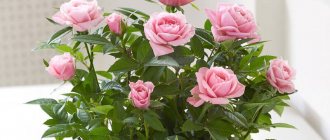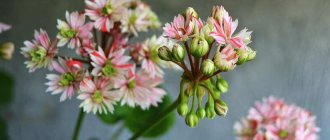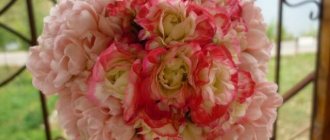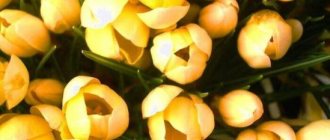Description of appearance
Rosebud geranium is a perennial that belongs to the Geranium family. It is distinguished by a branched rhizome. It has a herbaceous and tough stem, which over time becomes woody at the bottom. The leaves are lobed, the cutouts on the leaf blade do not exceed 1/3 of the half-width. The fruits of the plant are box-shaped.
Attention : Geranium is propagated by seeds and cuttings. The plant has a positive attitude towards abundant watering and loves warmth.
Difference from tulip-shaped
Very often these two types of plants are confused with each other. But rosebud geranium is distinguished by more lush and double flowers, reminiscent of roses and collected in large inflorescences.
What it is?
Zonal geranium is a very lush perennial subshrub with a straight stem, which is densely covered with green, rounded, jagged leaves; they are attached to the trunk with a long petiole. The height can reach up to a meter.
Along the edges of the sheet there are brown or dark green edgings in the form of circles, zones painted in a different color stand out, which is why the name “zonal” comes from it.
At the top of the stem, on long peduncles, there are flowers of various colors, collected in spherical inflorescences or in umbrellas. When you press the stems and leaves, a peculiar tart aroma comes out , since the plant contains healing essential oils.
Popular pink varieties and photos with them
Let's consider varieties of beautiful rosebud geranium. Also in the photo you can see blooming rosaceous plants, for example, Rosita with bright pink flowers, or Terry with amazing crimson roses and other varieties of geranium.
Apple Blossom Rosebud
This plant forms small perennial bushes with large and lush apical inflorescences. The umbrellas are dense, obtained from densely double buds. The only drawback of the culture is its tendency to grow rapidly , as a result of which it is necessary to regularly prune.
Tulip-shaped
This is a miniature bush in which all the inflorescences are collected together. They have a dark pink color. Caring for the crop is not difficult, which is why the variety is so valued by gardeners. You can learn about tulip-shaped geraniums, cultivation characteristics and varieties of this type of flower here.
Red
This is a miniature plant that does not grow much. The apical shoots are burgundy in color, and chaotic strokes are scattered across the petals of the flower . The disadvantage of this variety is that it is difficult to get side shoots, so it is not always possible to form a bush.
Terry
This is another amazing variety of rosebud geranium, whose buds take on crimson, purple and coral colors. They bloom like umbrellas.
Rosita
This variety fascinates with its beautiful flowers. Their shape is reminiscent of buttercups, but they have a terry structure and a bright pink color. The plant develops slowly, but flowering lasts a long time - for 2 weeks.
Varieties and varieties
Thanks to selection, various varieties with lush flowering and varied colors have appeared. Not only the inflorescences are beautifully colored, but also the leaves of some varieties.
Vectis rosebud
Vectis rosebud
The variety is characterized by its small size, and dense inflorescences of double buds are formed on long peduncles. The petals are colored red, the outer side of the petal is always lighter.
Pac viva Rosita
Pac viva Rosita
One of the most popular varieties for indoor growing. But to obtain lush flowering within 5-6 months, the plant needs attention. Regular watering and fertilizing will allow the formation of double buds on long peduncles. Each inflorescence contains 15-16 flowers.
Appleblossom rosebud
Appleblossom rosebud
The variety has a beautiful heterogeneous color. The color of the petals changes from white to light green. The edge of the petal has a pink edge. The leaves are rich green. The plant grows quickly and needs regular pruning. Old stems lose their leaves and decorative appearance.
It is believed that this is the favorite variety of the Queen of England.
April snow
April snow
The white, large flowers of this variety have distinctive pink stripes along the edges. Which adds volume to the flowers. The bud is multi-petalled, loose. The leaves are large, emerald green.
Millfield rose
Millfield rose
This pink pelargonium is most often found in landscaping. The excellent combination of zonal and ivy-leaved pelargonium made it possible to obtain this delicate hybrid. Very resistant, able to withstand sudden changes in temperature and cold snap. On hot days it is necessary to increase watering. The buds are large, collected in a dense inflorescence, pale pink. The bud shape is ovoid, very reminiscent of roses. It takes a long time to enter the phase of active growth and flowering (not earlier than the second year).
Denise
Denise
This pink geranium was bred from the group of zonal pelargoniums and retained all their positive qualities. Despite the fact that the bush is medium in size, pruning must be done regularly. Delicate buds with a pink gradient are collected in a perfect spherical inflorescence. The leaves are green, with a darker area like all zonal varieties.
Anita
Denise
An excellent variety that does not require special attention and strong regular pruning. The plant is compact, up to 50 centimeters. The leaf blades are light, slightly corrugated. Caps of delicate pink buds form on long peduncles. The petals are round in shape, collected in dense buds and inflorescences. The buds do not open until the end, which makes them look like garden roses.
Achievement
Achievement
A distinctive feature of this variety is the soft silky sheen on the pink petals. The buds are multi-petaled, loose, and open widely. The petals curl slightly outward. The leaf blade is light green with a zonal ring. The bush is medium in size, requires pruning, but is easy to care for.
Pink rambler
Pink rambler
A medium-sized plant with dark pink petals. The outer side of the petal is noticeably lighter. The leaf plate is corrugated, green. The bush is perfect for outdoor landscaping and requires constant pruning.
Pac viva Carolina
Pac viva Carolina
This varietal group is characterized by very large inflorescences. The densely double buds have greenish tints and become lilac as they ripen. As the buds open, they reveal a green center. The subshrub grows up to 1 meter and continues to bloom for 6 months. Leaves are smooth, with a glossy sheen
Where and how to plant it?
It is better to replant the plant in March. To do this, you need to prepare a spacious plastic container. Lay a layer of drainage and fill 1/3 of the container with nutritious soil purchased at the store.
After the preparatory work, replant the plant using the transshipment method, distribute the roots and add soil, compact it and water it.
Lighting and location
To grow rosebud geranium, you need a well-lit room in which there will be no direct sunlight. But a room that is too dark and shaded is not suitable, because geranium is a light-loving crop. It is important to monitor the room temperature, which should be 17-23 degrees Celsius.
Soil requirements
Rosebud geranium prefers to grow in loose, moist and nutritious soil. It should be well breathable and have a neutral pH level.
You can buy soil in a specialized store or prepare it yourself . If you prepare it yourself, you will need to mix the following ingredients:
- turf soil - 4 parts;
- peat – 2 parts;
- sand – 1 part;
- perlite – 1 part;
- humus - 2 parts.
Home care
Humidity and watering
The plant does not have any special requirements for humidity, but it is important to maintain it within 60-70%. To do this, the room must be regularly ventilated.
Frequent moistening is unacceptable for geraniums, as this causes them to rot . It is necessary to moisten the soil as needed. Also check it regularly for moisture. If there is liquid, then there is no need to water the plant. When the soil crumbles and leaves no traces on your hands, it is simply necessary to irrigate it.
Do not use hot or too cold water for irrigation. It is better to use liquid that has settled in advance.
Tip : Geranium should be sprayed with a spray bottle every week. Wipe the leaves and stem with a damp cloth.
Feeding
It is recommended to use fertilizers before and during flowering . In spring, mineral fertilizers are used. They are used once every 2-3 weeks, and the dosage is calculated individually. As soon as the buds begin to form, add phosphorus-potassium compounds to the fertilizing. At the beginning of autumn, additional drugs are eliminated so that the plant can prepare for winter.
Trimming
The plant should be pruned after it has flowered. First, you need to inspect the flower and remove those parts that need to be fixed. If the stems are too long, remove them. If it is necessary for new shoots to form, then pruning should be done above the node.
In autumn, the stems need to be cut back by 1/3 . But since the flower continues to grow in winter, after the formation of the 5th bud, the bush needs to be pinched.
Common diseases and pests
When growing rosebud geranium, the following problems are possible:
The leaves are withering . This is a signal that the room is too warm or the plant is standing near the radiator. To save the flower, you need to increase the humidity and increase the air humidity.- The leaves have changed color . This indicates too much watering or not enough light.
- Spots on leaves . They indicate a viral infection. To save the flower, it must be transplanted into another soil and the plant treated with fungicides. Also conduct an inspection for parasites. In any case, it does not interfere with treatment with an aspirin solution (1.25 per 10 liters of water).
- The flowers are drying up . This is a symptom of fungus. To combat it, you need to treat the plant with Bordeaux mixture 5% or phytosporin.
- Whitefly and aphids. Fitoverim is used for processing. Be sure to treat the plant that is located nearby.
- Gray rot . This is the most dangerous enemy. The disease can be recognized by the presence of brown spots on the leaves of the flower. It is characterized by rapid spread. Treatment must be comprehensive. For these purposes, fungicides are used, nitrogen-containing fertilizers are excluded, watering and spraying are reduced, and soil looseness is monitored. In addition, the room should be well lit.
- The plant is withering . This is the result of fungal activity. The disease can be recognized by the presence of yellow and wilting lower leaves. If no action is taken, yellowness will begin to affect the remaining leaves. Trichodermin is used for treatment. You also need to change the soil mixture, as some fungi can remain viable in the soil for 15 years.
Caring for terry pelargonium
Regardless of the type, terry pelargoniums are not demanding to care for, unless it is an ampelous form (ivy-leaved variety) - it is more whimsical and delicate. The first thing you should think about is the temperature. Despite the fact that pelargonium is often called a house geranium, it is not one. This variety does not have resistance to cold and especially frost. The maximum temperature drop that can withstand is +10 degrees of heat.
In summer, you can keep the plant on an east or west window. On a windowsill with a southern orientation, it is recommended to shade perennials, especially if we are talking about ivy-leaved species. In dry times, outdoor flowers are watered more often, regulating water exchange so that moisture does not stagnate in the soil and does not provoke the development of fungus.
In winter, you don’t have to put the plant into dormancy if you can provide it with optimal daylight hours. If you keep terry pelargonium outdoors in the summer, then so that the next season it can adapt to the street again, cut the plant under the stump in the fall and leave it to overwinter in a cool room. The optimal wintering temperature is 10-12 degrees Celsius.
Lighting plays an important role. It is responsible for the abundance and duration of flowering. With a lack of light, the bush loses its neat appearance and begins to grow strongly, stretching the stems towards the light. On long shoots, loose and non-decorative inflorescences with small flowers may form. It is best to provide the plant with long daylight hours with bright, diffused lighting.
Features of reproduction
To propagate rosebud geranium, the seed method and cuttings are used.
Seminal
- Wrap the planting material in damp gauze. Leave it for 7-10 days in a room where there is no dry air. During this time, monitor the moisture content of the fabric.
- When the seeds swell, transplant them into the prepared substrate. Cover the container with polyethylene and water the soil regularly.
- As soon as a sprout appears and 4 leaves grow on it, the film can be removed and the plants can be planted in separate pots.
- The grown plant is placed in a container of suitable volume. It is better to use a clay pot, as this material allows air to pass through better. Drainage laid in a layer of 3 cm will prevent rotting of the root system.
Cuttings
Geranium cuttings can be carried out throughout the year , but the best time is from March to July. Procedure:
Cut a semi-lignified cutting from the mother plant, which will have 3-5 internodes, since the green and grassy one will not take root.- Use only purchased soil, adding vermiculite to it.
- Pour the nutrient mixture into transparent plastic cups and plant the prepared cuttings. Preparation of planting material includes cutting, removing leaves and air drying for 30-40 minutes.
- In the first days, water carefully so as not to overwater or overdry.
- Rooting of cuttings occurs under lamps for 2-3 weeks.
- As soon as the first roots form, you can add more fertile soil.
The familiar geranium, this unpretentious and incredibly beautiful flower, is famous for its most amazing variety of species and varieties. How to choose what to plant in the garden or on the windowsill? Our articles will help you navigate. From them you can learn about the perennial Peony and the annual Robert, about Rosanna, which blooms all summer, about hybrids of the Angel variety and the interesting Plenum geranium, read what is good about Max Fry, how to care for the fragrant Lemon and fragrant, how to grow black geranium.
Comments (11)
Yana
09.29.2017 at 00:21 |
My red geranium roses grew and bloomed beautifully in my old apartment, but after moving, it began to shed its leaves. Unfortunately, the windows of the new apartment face north, even in summer there is little light. I'm thinking about buying a plant lamp before the geraniums completely disappear.Answer
Andrey Expert Fruit Garden
27.10.2018 at 14:55 |
Good afternoon, Yana! Yes, using a phytolamp can significantly improve the life of your seedling. But we want to warn you that what is useful for plants is not always useful for you and me! The same applies to the spectrum of the lamp. It is harmful for a person to be in the places where they work! Therefore, you have a choice: either turn on the lamp while you are away from the kitchen (so as not to injure your eyesight), or equip a “Growbox” in your apartment, equipped with phytolamps, but protected from unintentionally getting an excess part of the spectrum into your eyes.
Answer
Basil
04/22/2019 at 00:36 |
Don't scare people with your ignorance. Plants calmly survive the winter under LED lamps of 10-20 W 4000k and some grow and bloom.
Answer
Yulia Expert Plodogorod
04/22/2019 at 07:20 pm |
Hello, Vasily! Indeed, it is worth noting that lamps for indoor flowers exist in several types and have different effects on humans and plants.
Fluorescent phytolamps contain mercury. But as long as the flask is intact, it poses no danger. This type has a certain negative effect on human vision due to the increased pulsation coefficient, that is, the blinking of the light source. This influence manifests itself in irritability and fatigue.
Mercury products are not as effective directly for illumination, but they are also less harmful to health than the previous type. The risk increases if the integrity of the lamp is compromised. Sodium varieties are also less harmful than fluorescent ones, however, with prolonged exposure they can provoke eye diseases.
As you noted, LED light sources are the best option for a number of reasons. They pulsate less and are more effective for indoor flowers. Long-term interaction can cause visual strain and fatigue; this should be taken into account, for example, when reading or working at a computer near a plant, which requires additional lighting.
Low power almost completely eliminates even this risk. We would like to note that in cheap options there may still be increased pulsation, so it is better to choose more expensive analogues.
In general, low-power LED phytolamps are considered the safest.
The previous comments about the dangers of some lamps are quite appropriate so that the user can choose the appropriate safe option.
Answer
Ira
04/12/2018 at 00:14 |
I’m looking for just this type of geranium to grow at home on the windowsill, but unfortunately neither my friends nor relatives have such a plant, and unfortunately, they don’t have it in stores either.
Answer
Yulia Expert Plodogorod
08.11.2019 at 01:16 |
Hello, Ira! You can try growing a variety of geranium from seeds. As a rule, such planting material is much easier to purchase both in the store and online.
It is better to carefully examine the resulting seeds, choose matte, brown, oblong-shaped seeds with two parallel depressions on the side. The shells on the seeds should be leathery, dense, and they themselves are quite large. If the seed is small, flattened, deformed, or has any other deviation from the quality material for planting, it is better not to use it.
We would like to note that sometimes geranium seeds do not germinate for a very long time. This period can last up to 3 months. Don’t despair and, most importantly, stop caring for the planting. You just need to give the flower more time. Scarification will help speed up this process.
This means that you need to remove the top layer of the seed. Then nutrients will flow faster. Fine-grain sandpaper is suitable for the described purpose. The movements should be slow and circular. It is important not to damage the seed too much.
Soil composition is important for the germination rate and health of the crop. It is important that the substrate is not overly saturated with nutrients. This results in slow development, thicker stems, poor or even no flowering.
To make sure that the soil is suitable for pelargonium, it is better to prepare it yourself rather than rely on a store-bought substrate. To do this, we recommend using turf soil - 50% of the total mixture, and 25% each of sand and peat. The last element must be deoxidized, since geranium develops better in neutral soils.
When the mixture is ready, we recommend disinfecting it in the oven. Afterwards, you need to let the substrate stand for 1.5-2 weeks so that the beneficial microflora in the soil, which also died during the calcination process, is restored. You can also simply pour boiling water with the addition of boric acid onto the soil. Toga planting can be done faster, in a day or two.
A small pot will do for the geranium sprout. It is convenient to use small glasses for seedlings. They already have drainage holes and are quite stable.
The prepared containers need to be filled with substrate and moistened with warm water. Next, you need to make a small hole in the glass, 1-1.5 cm deep, then lower the seed into it. Afterwards, watering is carried out again and the containers are covered with film.
You can sow the plant in one large container. It is important to maintain a distance of 2-3 cm between seeds and between rows. It is better to place containers with flowers in a warm and dark place. We recommend ventilating the geranium once a day and monitoring the humidity.
When sprouts appear, the cover must be removed and young geraniums must be provided with good lighting. After 2-3 leaves appear, you can pick. And after 5-6 leaves appear, you should pinch the plant.
Answer
Olga
05/23/2018 at 12:04 |
For some reason, my geranium roses do not form a head of flowers, only a few flowers in an inflorescence. I take care of it correctly, the soil is good, watering is moderate, the place is bright. I don't understand the reason. Maybe someone can tell me?
Answer
Yulia Expert Plodogorod
08.11.2019 at 01:57 |
Hello Olga! There are several reasons why geraniums do not bloom well. Sometimes, such plants show no signs of disease or other problems, have beautiful greenery and even produce new shoots.
This often happens, even with good care and suitable soil, if the wrong pot is chosen for the plant. If the container is too large, the geranium will spend energy growing rhizomes to fill the entire available area. This often results in few or no buds.
After the rhizome fills the container, the crop will not grow again, as it will build up the corresponding vegetative mass and spend all its energy on this process.
In the described case, you need to transplant into a pot that corresponds to the size of the rhizome. If you only have a large pot, you can plant two plants in it. But, in the future, the rhizomes may become intertwined, so replanting may be difficult. In addition, it will no longer be possible to seat such a couple.
Please tell us more about what kind of soil is used. The fact is that for geranium you should not use a substrate that is too nutritious and rich in nutrients. Unlike many other crops, this can negatively affect the flowering process.
We recommend preparing the soil for adult geraniums as follows: forest soil 50%, 20% humus, the same amount of deoxidized peat and 10% sand. Once a season you need to replant and replace the substrate. If the geranium has not been replanted for a long time and the soil is too depleted, the crop may not have the resources to produce buds.
It is important not to oversaturate the soil with fertilizers, but also not to make it completely poor. The substrate for geraniums requires a balance.
Although geraniums do prefer plenty of light, they can suffer from sunburn. This damages the crown, reduces immunity, and, accordingly, flowering deteriorates. It is better that the midday rays do not fall on the flower. It needs to be closed during this period or choose a place that is well lit in the morning and evening hours.
It is important not only to properly moisturize geraniums, but also to use suitable water for this. It must be filtered or thawed. You can use well-stood water, in which harmful impurities have settled.
For flowering, it is important to properly fertilize geraniums. During the period of active development, mineral fertilizers can be used. But they should not contain a lot of nitrogen, no more than 10%. Potassium and phosphorus should predominate. It’s good when it contains boron, but in small doses.
Wilted buds should be removed immediately. When a plant blooms, it is better to disturb it and rearrange it as little as possible. In winter, the flower is rarely watered and not fertilized. Suitable temperature for wintering is 11-12 degrees. It is important to ensure such a reduction in temperature in winter. If this does not happen, flowering may not occur even if all the rules are followed.
Answer
Alla
06/18/2018 at 11:08 |
I have a beautiful geranium growing with roses, bright red. I bought it at a flower shop. After a few months, the leaves began to turn yellow and fall off. There are a couple of sheets left at the top. I water on time, the soil is of high quality. Please tell me a good fertilizer.
Answer
Expert Fruit Garden
09.13.2018 at 13:03 |
Good afternoon, Alla! Unfortunately, the flower business is currently a real battlefield. On the one hand, producers of planting material are fighting (often not entirely honestly), and on the other, we, the buyers. At the same time, not every buyer knows the conditions that a particular plant needs. In addition, manufacturers often use chemicals aimed at short-term “selling” beauty. Unfortunately, they don’t care about what will happen next to the seedlings. Returning to your geranium, I can recommend the following: Cut the cuttings while they are still alive and try to root them yourself. If the geranium's root is viable, it will produce new shoots. As a fertilizer, I can recommend Osmokot, which has (thanks to its resinous coating) a long absorption period. So, you don’t have to feed your pet often!))
Answer
Olga
08/31/2020 at 16:07 |
Pelargonium roses bloom poorly
Answer











